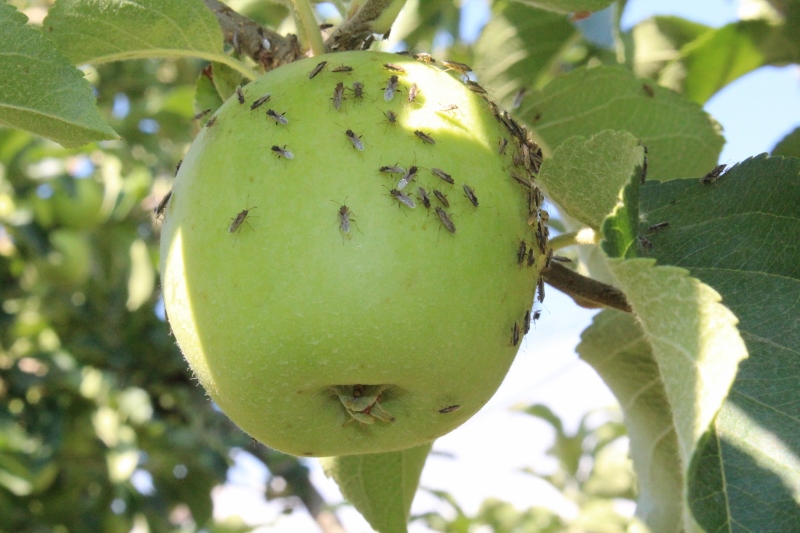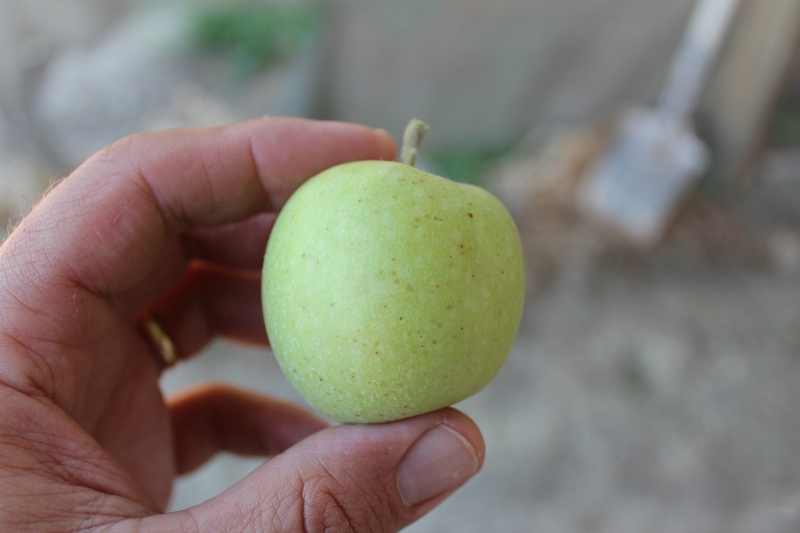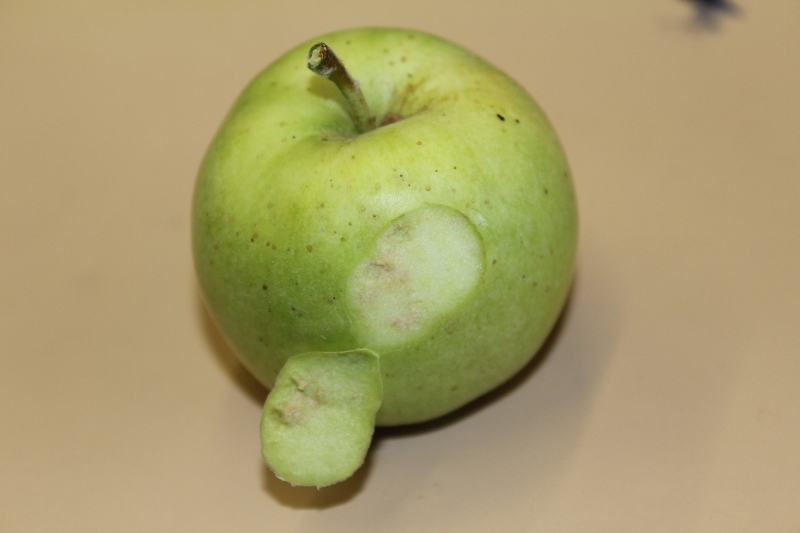Rutherglen bug
The Rutherglen bugs are most likely adults flying into crops as the surrounding bush and weeds dry out. Historically, it is much less common to see significant bug numbers in apples and pears than in stone fruits.
Rutherglen bug adults are not likely to cause issues for pome fruit at this stage of development. However, while unlikely to cause damage in orchards, there have been cases such as shown in these images of a severe infestation of Rutherglen Bug in apples recorded at Tumut, NSW in January 2014). In this case bugs were clustered on leaves and fruit and there was sucking damage to the fruit which was detectable in the fruit flesh after peeling (information and photo credits: Kevin Dodds, NSW DPI).
The NSW DPI orchard guide includes information on Rutherglen Bug as a pest of both Pome and Stone fruits on page 51. Here’s the link to the full document. https://www.dpi.nsw.gov.au/__data/assets/pdf_file/0007/1185154/Orchard-plant-protection-guide-2019-20.pdf NOTE : users of the guide must be aware that chemicals listed in the guide are registered in NSW and may or may not be registered for use in other states or territories.
Because of the transient nature of bug populations (i.e. not there one day and there en-mass the next), regular monitoring is a key IPM tool for early detection. Unfortunately, however, there are no IPDM compatible options when the Rutherglen bugs arrive in high numbers and are all adults.
There are no “soft” chemicals that will kill them so if a grower is very concerned and wants to spray for them then a synthetic pyrethroid is really the only option. In NSW the only chemical registered for control in Pome fruit is the active ingredient Trichlorfon (Lepidex®). As use of most synthetic pyrethroids have flow on effects against beneficial insects, especially mite predators, growers will need to consider ordering predators in advance to re-stock the orchard after spraying.
Another thing to consider is how effective spraying for Rutherglen bugs will be as they will most likely continue to fly in on hot nights for the next few weeks. So you could spray for them and have just as many fly in the next night.
Would an IPDM – Cultural approach be to keep the inter row moist during high risk times?
Would an IPDM – Cultural approach be to keep the inter row moist during high risk times?
Keeping the inter-row moist during high risk times would probably be counterproductive for at least two reasons. The bugs are seeking moisture, which is provided by the trees and irrigation, and wetting the inter-row may simply increase the attraction of bugs into the orchard from dry(ing) pasture nearby. Keeping the inter-row moist would also require more irrigation water, at a time when supply is limited and therefore cost is high.
Wetting the inter-row would encourage greater growth of vegetation in the inter-row, which would then require mowing. If that was to happen then use of a side-throw mower to distribute the cuttings a mulch onto the tree line should be considered, although the use of the mower would disturb the bugs and possibly drive them into the trees.
A longer term, IPM friendly approach would be to consider establishing roosting sites for microbats that consume large numbers of insects per night. This may not completely solve the bug issue because of the sheer numbers of bugs and the sporadic nature of their occurrence, but microbats prey on a wide range of flying insects including moths. Insect proof netting would stop incursions of Rutherglen bugs if installed early enough but is horrendously expensive and will prevent access by beneficial species (such as predatory insects, pollinators such as bees and flies, and insect-feeding microbats) and therefore lead to other pest problems developing.
Is there an alternative catch crop (header planting or herbacous species) that we can consider?
Thank you for the replies, luckily with the current IPDM practices less and less mowing is taking place to allow the build up of beneficial insects within the canopy.
The problem is that the bugs are moving in from pasture outside of the orchard. If it is your own pasture you might consider planting a reasonable sized wind break but this is a long term solution for a short term problem that appears to need an instant response. As far as I know there is no information on suitable species to plant.
A key predator of Rutherglen Bug is the Southern Freetail Bat, studies through ARI showed that their diet consists of 80% Rutherglen Bug. When considering an IPDM program, don’t just consider invertebrates as predators, encourage insectivorous birds and bats as well. This means supporting their habitat. I am working on a tutorial at the moment on how to document a farm biodiversity plan. Happy to share it once it’s completed. A template will be on our CMA website but I’ll share into this group if there is interest. The Rutherglen Bug research is contained within this factsheet:
http://www.basalttobay.org.au/images/downloads/fact%20sheets/EBONS-Report-Issue-3-2015_.pdf
https://www.swifft.net.au/cb_pages/insectivorous_bats_of_victoria.php
Hope this is helpful, Karen Thomas PPWCMA
Very helpful thanks Karen. Unfortunately most of the work has been done on grazing and broad acre cropping. Horticulture, as you know, has a range of issues that can be exacerbated by poor choice of windbreaks and the long term nature of the research required to sort them out has discouraged funders. Your work in the Yarra Valley is providing interesting results and your continued input to this forum is welcome.
Dave




We are seeing many Rutherglen bugs on orchards in the Goulburn Valley. What sort of damage can we expect and are there any IPDM control methods?